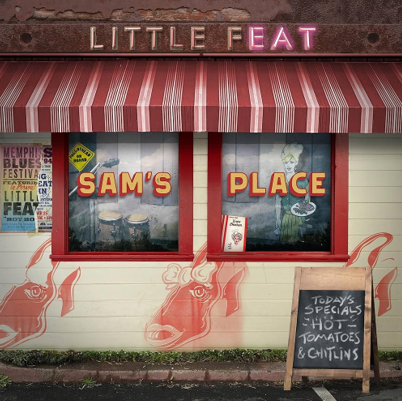When I spotted Little Feat in my “Release Radar” new music playlist curated by Spotify last Friday, I first thought they must have re-issued one of their old albums. A closer look quickly revealed I was wrong and that song in the playlist was taken from a new album titled Sam’s Place, released last Friday (May 17). Not only is it the storied group’s first since 2012, but it’s also their first all-blues album. And while all of the nine tracks except for one are covers, I can highly recommend it to anyone who digs the blues.
Little Feat have been around since 1969 though after their break-up in 1979 had an 8-year interruption until their reformation in 1987. While I had known of them for a long time, my introduction only came in March 2018 after my dear German music buddy Gerd recommended Waiting for Columbus, their excellent first live album from February 1978 I reviewed here. Subsequently, I also more deeply explored Dixie Chicken, the group’s great third studio album released in January 1973. You can read more about it here.
As you might expect for a band with such a long history, Little Feat have seen many line-up changes. Initially, they included singer-songwriter, lead vocalist and guitarist Lowell George, who led them for the first 10 years, Bill Payne (keyboards, piano), Roy Estrada (bass) and Richie Hayward (drums). By 1972, the group had grown into a six-piece who in addition to George, Hayward and Payne featured Paul Barrere (vocals, guitar), Sam Clayton (congas, percussion, vocals) and Kenny Gradney (bass).

Shortly after their break-up, George passed away in June 1979 at age 34 from a heart attack caused by a heroin overdose. In 1987, surviving members Barrere, Clayton, Gradney, Hayward and Payne revived Little Feat, and added songwriter, vocalist and guitarist Craig Fuller and Fred Tackett (guitar, mandolin, trumpet). The band’s line-up continued to change over the years and currently includes Payne as the only remaining co-founder, along with Tackett, Clayton and Gradney, as well as Scott Sharrad (guitar, vocals) and Tony Leone (drums), who joined in 2019 and 2020, respectively.
While Sam’s Place is Little Feat’s first all-blues album, blues has always been an ingredient of the group’s tasty musical gumbo that also has included rock, funk, folk, jazz, country, rockabilly and New Orleans swamp boogie. One thing that’s new is Clayton’s dominant role on lead vocals throughout the album. A review in Blues Rock Review compared his gravelly vocals to Howlin’ Wolf. Sam’s Place was recorded live in studio at Sam Phillips Recording in Memphis, Tenn., except for the closer, which was captured before a live audience. A review in Glide Magazine noted the album was co-produced by Little Feat and engineer Charles Martinez.
Time to take a closer look at some of the goodies. Here’s the opener Milkman, the album’s only original song co-written by Clayton, Tackett and Sharrad. BTW, if you’re into Gregg Allman, the name Scott Sharrad might ring a bell. He joined Allman’s backing band in 2008 and became their musical director until Allman’s death in 2017. The tasty horn action is provided by Marc Franklin (trumpet) and Art Edmiston (saxophone). Great stuff!
As a longtime fan of Bonnie Raitt, of course, I couldn’t skip Long Distance Call, which features her on vocals together with Clayton. Sharrad shines on Dobro resonator guitar, while the neat harmonica action is provided by Michael “The Bull” LoBue. The song was written by Muddy Waters who first released it as a single in 1951. Little Feat and Raitt go back to the early ’70s when she first sang backing vocals on the group’s above mentioned Dixie Chicken, as well as the August 1974 follow-on Feats Don’t Fail Me Now. “I’ve always loved Little Feat and this new incarnation of the band is bringing some serious heat, cred and new blood to their enduring legacy,” Raitt said.
Don’t Go Further is another stands out track. The song was written as “Don’t Go Farther” by Willie Dixon in 1956 and first recorded by Muddy Waters and released under Muddy Waters and His Guitar the same year. I love this great shuffle!
Clearly, Little Feat must have a thing for Muddy Waters, and who can blame them. Can’t Be Satisfied is a rendition of another song by Waters who wrote and released it as I Can’t Be Satisfied in 1948. The official video features neat footage from Sam Phillips Recording studio. “You can’t make a blues album without playing some Muddy Waters and Little Feat has performed this on live shows over the years,” Sharrad told Rock & Blues Muse. “What sets this rendition apart is Tony Leone’s nod to Levon Helm with the drum groove. This arrangement takes you from Mississippi, up to Chicago and lands down in Arkansas, where both Fred Tackett and Levon Helm were born.”
I could easily go on and on since I dig all of the album’s nine tracks. Let’s wrap it up with the aforementioned live version of Got My Mojo Working. Written by Preston “Red” Foster, the blues classic was first recorded and released by R&B singer Ann Cole in 1956. The following year, Muddy Waters released the song with some changed lyrics and an arrangement that altered Cole’s more doo-wop-oriented style to a driving jump blues rhythm. Yes, it’s been done many times, but you can feel the joy Little Feat had performing the song, so it’s certainly a worthy cover.
Little Feat will go on the road starting at the end of this month, sharing bills with Tedeschi Trucks Band, The Wood Brothers and Los Lobos, among others. Seeing them with any of the other aforementioned bands sounds like a fun proposition. The current tour schedule is here. I’m leaving you with a Spotify link to the album:
Sources: Wikipedia; Little Feat website; Blues Rock Review; Glide Magazine; Rock & Blues Muse; YouTube; Spotify









